The third largest dome in the world in Iran

The Soltanieh Dome was erected between 1302 to 1312 and is located in Zanjan province. It is the earliest existing example of the double-shelled dome in Iran and the third largest dome in the world after domes of Florence Cathedral and Hagia Sophia. Much of its exterior decoration has been lost, but the interior retains superb mosaics, faience, and murals. People have described the architecture of the building as “anticipating the Taj Mahal.” It is outstanding by virtue of its innovative engineering structure, spatial proportions, architectural forms and the decorative patterns and techniques. It has 8 elevated porticos and approximately 50 chambers.
The Soltanieh Dome stands in the middle of a rural settlement, surrounded by fertile meadows. The building is octagonal in form, rising to a stunning high-profile dome 50 meters high and covered with turquoise-blue faience tiles. The dome, consisting of two parallel and separate brick layers, is surrounded by eight slender minarets as a decorative feature. A wide band of square Kufic around the drum makes a transition between the light blue and the lapis lazuli blue of the main stalactite cornice. The interior walls were originally adorned with light golden-toned bricks and dark blue faience tiles to form large inscriptions in Kufic. However, in 1313, it was redecorated with plaster, using a rich variety of fine ornaments, often worked in low relief. The second phase of the decoration belongs to the period when the use of the monument as a shia shrine was given up. The decoration of the exterior belongs to the first phase.
Sultan Muhammad Khodabandeh of the Ilkhanid dynasty came to power in 1304 and decided to enlarge the area and make it his capital, naming it Soltanieh. Soltanieh became a major trading center on the route between Asia and Europe in the 14th century. Originally the Soltanieh Dome was meant to house the relics of Imam Ali and his son, Hussein, from Baghdad to Soltanieh. This never happened, though, and the shrine became the mausoleum of Muhammad Khodabandeh instead. After the death of Khodabandeh in 1316, the city started losing in importance, and later it fell in the hands of small local dynasties. In the 16th and 17th centuries, Soltanieh gradually declined and remained in ruins. Some restoration was undertaken in the Soltanieh Dome in the 19th century.
The Soltanieh Dome has been undergoing extensive renovation periodically. In 2008 Iran's Cultural Heritage, Handicrafts, and Tourism Organization (ICHTO) refurbished the brick structure's exterior with azure tiles made in traditional kilns over a four-year period. Some 100,000 tiles were used to restore the structure.
In 2005 the World Heritage Committee approved to include the Soltanieh Dome in its list of World Heritage.
.....
.....
.....

.jpg)



























